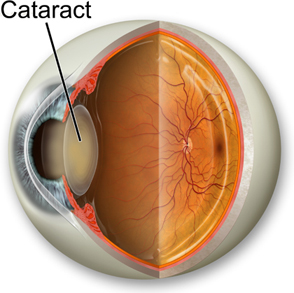Cataract
A cataract is a clouding (opaqueness) of the normally clear lens of the eye, which can interfere with vision. Many Australians will have some degree of cataract by the age of 70 years. Cataracts tend to develop slowly, and at first you may not notice any symptoms. As the cataract gradually gets larger and affects more of the lens in your eye, symptoms become more noticeable.
Symptoms of cataracts include:
- sensitivity to glare and bright lights;
- seeing haloes or starbursts around lights;
- seeing colours as faded or yellow; and
- blurred, foggy or hazy vision.

Pterygium
A pterygium is a visible growth on the surface of the eye. It typically emerges as a triangular, soft-tissue growth from the corner of the eye, with a pink and fleshy appearance. This growth is the body’s way of trying to protect the eye from intense environments, such as high levels of sunlight, dust, sand or wind. Surfers are one group of people who are prone to developing this condition, which is also known as Surfer’s Eye. Other at-risk groups include farmers, welders and people living in northern (sunnier) areas of Australia.
In general, pterygia (plural) are not dangerous. During the early stages of pterygium development, the main concern is cosmetic – they change the eye’s appearance – but there is no effect on vision. Symptoms in the early stages may include irritation, itching or burning. These can generally be managed with eye drops. Avoid further exposure to sunlight and wind to reduce the stimulus for it to grow larger.
However, in some cases, the pterygium may continue growing across the eye and either directly block vision or distort the shape of the cornea and cause blurred vision (astigmatism). In these cases, surgery is recommended. Surgery is also an option if you are worried about the cosmetic appearance of your eye.
Importantly, pterygia are not cancerous – they are benign growths. That means that while they may grow locally (and possibly affect your sight), they won’t spread to other parts of your body. Nevertheless, it’s important that you have an evaluation of any growth on your eye to rule out more serious conditions.
Glaucoma
Glaucoma is the name given to a group of eye diseases where vision is lost due to damage to the optic nerve. Approximately 300,000 Australians have glaucoma. Generally, there are no symptoms or warning signs in the early stages of this eye condition. The loss of sight is usually gradual and a considerable amount of peripheral (side) vision may be lost before there is an awareness of any problem.
The primary problem in glaucoma is damage to the optic nerve. Intraocular pressure (IOP) is the fluid pressure inside the eye. The level of eye pressure at which there is progressive damage to an optic nerve varies between people: some individuals with high eye pressure do not develop nerve damage, while others with normal eye pressure develop progressive nerve damage.
The best way to protect your sight from glaucoma is to have your eyes tested.

Diabetic Retinopathy
Diabetic retinopathy is one of the most common complications of diabetes. It can develop in people with both type 1 and type 2 diabetes, and usually affects both eyes. People with retinopathy have damaged blood vessels in their retina – the light-sensitive layer at the back of the eyes.
Diabetic retinopathy develops slowly over many years, so regular eye checks are important if you have diabetes. Keeping good control of your blood sugar levels can help prevent retinopathy or slow down its progression. But if you do develop retinopathy, there are treatments available to help improve your vision
Macular Degeneration
Macular degeneration, also known as age-related macular degeneration (AMD) is the name given to eye disease that cause progressive loss of central vision, leaving the peripheral or side vision intact. It affects the ability to read, drive, recognise faces and perform activities that require detailed vision. Macular degeneration is the leading cause of legal blindness and severe vision loss in Australia, responsible for 50% of all cases of blindness.
Macular degeneration is usually related to ageing and most frequently affects people over the age of 50. However, it is not a normal or inevitable consequence of ageing.
Macular degeneration is progressive and painless and does not result in total vision loss.
